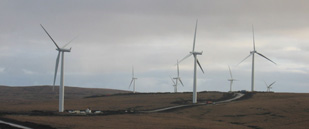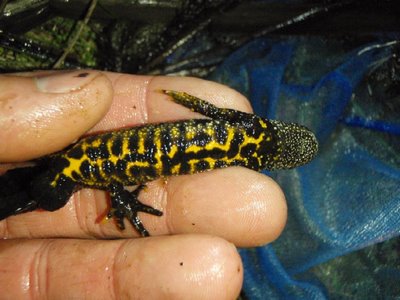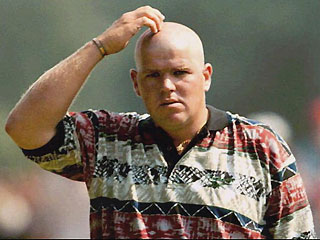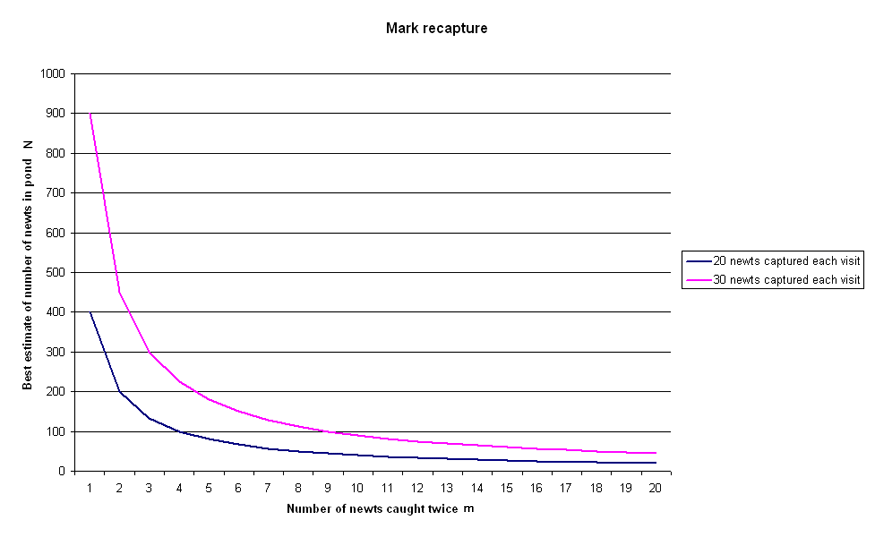Great crested newt discussions and research

Introduction
The news story suggests lots of interesting topics for discussion and research.
Take a look at those we've picked out from the text. Compare ours with those you found using the methods in Getting the topics.
In groups discuss the differences. This isn't about right or wrong. Your choice is as good as ours as long as you can explain and defend it.
Now have a go at some of the topics - ours or yours.
Selected topics
Well, this little amphibian is struggling to survive as a species in Britain
Newt-moving is done by experts in the impact of human activities on wildlife - known as ecological consultants
But science is about testing assumptions.
To study individual newts scientists need to be able to tell them apart.
So with a bit of effort a scientist can tell if the newt she captures today is the same one she captured a year ago
The fieldwork is done - the lovely outdoor part, the pulling on wellies and wading about
Want more?
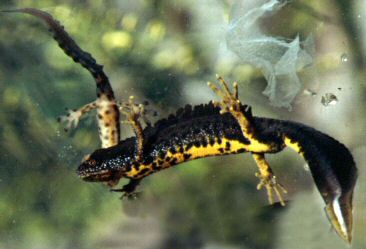
Well this little amphibian is struggling to survive as a species in Britain
So the question is - why?
In your groups learn all you can about great crested newts. Find out what is making their numbers dwindle.
Get a list of other animals that are endangered in Britain. Find out why each of them is engangered too.
Have a look for common factors among the reasons these species are struggling. In your groups organise a brainstorming session, throwing ideas around that could tackle one of these common factors.
Select one idea from this brainstorming that appeals to your group and has some chance of success. Prepare a presentation entitled "How we can help great crested newts and other endangered animals to survive." Deliver it to the class.
Useful websites
Great crested newts video
Endangered species Independent, Guardian
Great crested newts species action plan UKBAP
N Lanarkshire action plan
Cooperative learning:
Newt-moving is done by experts in the impact of human activities on wildlife - known as ecological consultants
Do a search on "ecological consultants" and "ecological consultancy" in this country. Take a look at the websites of the companies this produces.
Working in groups put together a poster, presentation, advertisement or website to market your own ecological consultant company. This will need to explain what you do and how you do it, and why Scottish Natural Heritage should come to you first if they 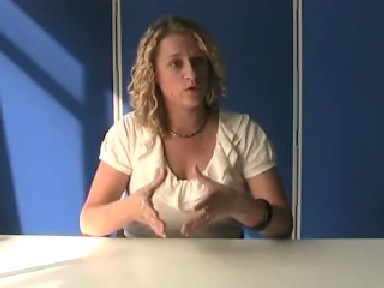 want to do a translocation of newts - or any other animal.
want to do a translocation of newts - or any other animal.
Oh yes, and you'll need a good name for your company too.
Listen to Debbie McNeill
What SNH wanted from Glasgow University
Useful websites
Cooperative learning: classroom organisation
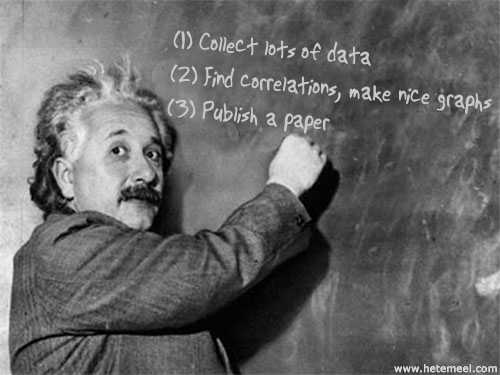
But science is about testing assumptions
Here's a question to get you scratching your heads: What is science?
Don't worry if you can't answer this question right away. Most scientists would have trouble answering it. They're usually practical people who find doing science challenging enough without wondering how to define it.
But we'd like you to take a step or two down the road of answering the question. To get you started, have a listen to a couple of other Glasgow University researchers on what made them want to do science:
Here's radio astronomer Graham Woan, who is part of a world-wide group of scientists searching for gravitational waves from space:
Now listen to Glasgow University's Stuart Reid, who is also helping in the hunt for gravitational waves. He's an experimental scientist. (This recording was made in Stuart's lab surrounded by fairly noisy machines, but his words are clear enough.)
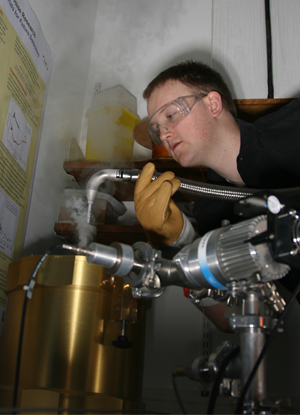
Finally have a listen to Debbie McNeill on some of the reasons she wanted to study newts and other amphibians.
So now you've heard from some scientists have a go, in your groups, at completing these sentences:
"A scientist is a person who ..."
"If I was a scientist I would do research on ..."
Useful websites
Cooperative learning
To study individual newts scientists need to be able to tell them apart
Fortunately their "very colourful bellies" can be used for this - the newts', not the scientists' - since every great crested newt has a different belly pattern.
Listen to Debbie McNeill
Animals of the same species often look alike to the human eye. But with a little scientific effort they can often be told apart and individuals identified. Scientists have come up with various methods for doing this for a number of different species.
Do an internet search on the following three words: "identify individual _______" where the blank can be any animal you choose. For example, dolphins, elephants, whales, bats and so on.
Choose three species and the methods scientists use to tell the individuals apart that seem interesting to your group. Prepare and deliver a presentation on these methods, highlighting aspects that particularly appeal to you.
So with a bit of effort a scientist can tell if the newt she captures today is the same one she captured a year ago
Listen to Debbie McNeill
So why does she go to all this trouble to find out if the newt she captures today is the same one she captured on a previous visit? Let's look at a simple case.
Suppose Debbie goes to a pond and captures 20 great crested newts one night. She puts them in her mander masher, photographs them, then returns them to the pond.
Six months later she visits the same pond and again takes 20 newts.
She compares the photographs to see how many newts were captured twice. It turns out to be a very small - say just 1.
What does that tell her about the total number of newts living in the pond? Is it likely to be a large number or a small one? [It might help if you imagine Debbie paints all the newts she captures the first time white - she doesn't of course - while the others are black.]
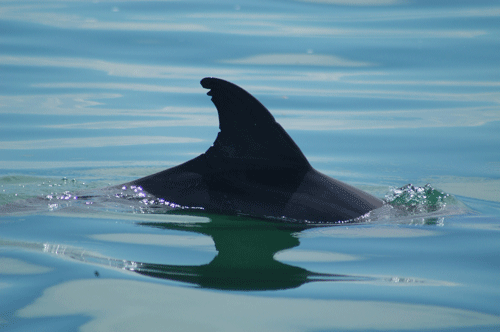
On the other hand if she captures a large number of the same newts on the second visit that she captured on the first, what does that tell you about the total number of newts living in the pond? [Again do the white-newt black-newt picture in your head.]
What you've just worked out in your mind is the basic idea behind the method Debbie is using.
It's called mark recapture and it's a method researchers often use when they can't count a whole population.
Mark recapture relies on the fact that the greater the number you catch twice, the smaller the total population. [Why?]
And the smaller the number you catch twice the larger the population. [Why?]
In your groups do an internet search and make a list of 10 different living things for which mark recapture has been used. What are the researchers trying to find out in every case?
Mark recapture maths can get complicated when you take account of all possible problems you want to avoid. But the basic idea, as you've just seen, is nice and simple. So is the basic maths.
Here it is:
If the two visits to a pond are close enough in time for the total population of newts to be the same at both visits (so no newts die, are born, leave the pond or come in from elsewhere) the estimate N of the total population is given by this formula:
N = n x n /m
where n is the number of newts captured on each visit, and m is the number of newts captured twice.
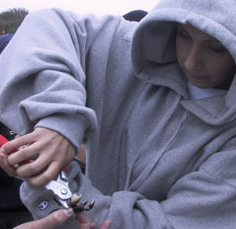
In words: The best estimate of the total number of newts in the pond is the square of the number you capture on each visit divided by the number captured twice.
Now let's take a look at what this formula is telling us. Let's say you capture 20 newts at each visit. So n is 20.
To get a graph all you do is plug the number 1 into the formula N=400/m.
Then plug 2 in. Then 3. All the way up to 20. You can do this by hand or using Excel, which makes it easier.
Now plot the results as a graph - again either by hand or using the Chart option in Excel.
Take a look at this graph and check that when m is a small number it's telling you the same thing as you worked out in your head earlier. Check that it's telling you the same thing as you worked out in your head when m is a large number.
Finally look at the graph and answer this question:
Will your estimate of the total population be more accurate if you're working on the right side of the graph, where it's fairly flat, or on the left side where it's steep? [Hint: if a newt you captured on the first visit wriggled away from your net on the second visit - changing m by 1 - would that make a big or small difference to N, your estimate of the whole population? If it's a big change your estimate will not be accurate, because chance events on the night make a big difference to the answer you get.]
So how can reduce the effects of chance events, like newts wriggling away? How do you make sure you're working on the flat part of the graph?
You want to make m large. But as a scientist catching newts you've no control over m - it's whatever number you get. And you don't know N.
But take a look at our simple mathematical model:
N = n x n /m
What number in this formula can the scientist control? What happens when she changes it?
So what should a scientist like Debbie do, when she visits the pond, to give her a good chance of being on the flat part of the graph, to make sure she gets an accurate estimate of the total population?
[We've provided a graph at the foot of the page that you can use to check yours and your ideas against. But try to answer all the questions first before taking a peek.]
The fieldwork is done - the lovely outdoor part, the pulling on wellies and wading about
Have a listen to Debbie talking about the aspects of her research that have given her most satisfaction.
Would the same sort of things appeal to you?
Real scientists usually think of themselves as either experimental scientists - those who build and carry out the experiments or fieldwork - or theoretical scientists - those who work on the theory, and try to explain and understand the experiments and suggest new ones.
Have a listen to Stuart Reid talking about the two types of scientist.
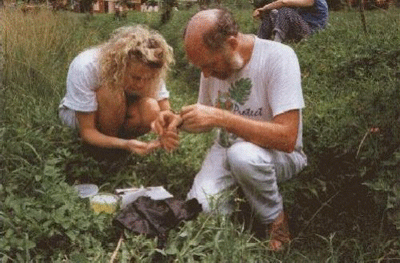
In groups decide which type of scientist you think Debbie is. Give reasons for your answer.
Now listen to what Stuart has to say about other types of people and skills needed to do real science.
Suppose you wanted to be a scientist. Which kind would you like to be and why?
At what stage in your education or career do you think you might have to decide?
Want more?
Getting started with the science
Monitoring methods for the great crested newt
Amphibia web searchable by country
Attract newts to your pond
Great Crested Newt Conservation Handbook
Grasshopper mark recapture

